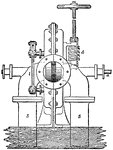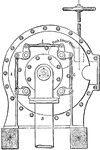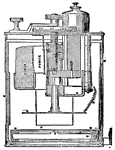Clipart tagged: ‘Thomson’

Absolute Electrometer
"Thomson's absolute electrometer is an adaptation of the attracted disc principle for absolute determinations.…

Liquid Air Machine
"A labratory liquid air machine used by Thomson and Joule used to cool hydrogen from a gaseous state…

Quadrant Electrometer
"Elevation and section of Thomson's Quadrant Electrometer." — Encyclopedia Britannica, 1893

Thomsons Galvonometer
"A very convenient form of Thomson's galvanometer, the only specimen of its kind we have seen. The peculiarity…

Reaction Turbine
"Professor James Thomson's inward flow or vortex turbine has been selected as the type of reaction turbines.…

Reaction Turbine
"Professor James Thomson's inward flow or vortex turbine has been selected as the type of reaction turbines.…

Reaction Turbine
"Professor James Thomson's inward flow or vortex turbine has been selected as the type of reaction turbines.…

Reaction Turbine
"Professor James Thomson's inward flow or vortex turbine has been selected as the type of reaction turbines.…
